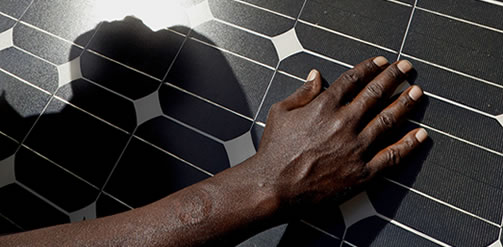Home to some of the world’s fastest growing economies, sub-Saharan Africa is currently facing a large electricity deficit, which results in frequent black-out periods and has an impact on education, health and business. This project is looking into the heart of the electricity supply crisis in Africa, asking what are the key blockages to green investment and how can we resolve them?

We are a research consortium based in Ghana, Kenya and the UK looking for the key areas of policy interventions to remove obstacles to investment in renewable technologies.
Once these areas have been identified, we ask how can these initiatives successfully navigate the choppy waters of real-world politics?
Six steps to Green Investment Diagnostics*
- Identify target technologies that are economically and financial viable
- Use economic and social indicators organised in a hierarchical decision-tree framework (see opposite) to make comparative assessment of potential constraints to investment in these technologies.
- Identify policy areas which are the most ‘binding’ via a deeper search for diagnostic evidence in areas identified as potentially problematic
- Identify most viable policy options in these areas given political economy realities in the country concerned using political economy analysis
- Simulate growth and distributional implications of increased investment in RE using Computable General Equilibrium modelling
- Model impacts of the integration of intermittent renewable energy generation in the national grid using power systems reliability analysis
Project updates
- June 2017: Research Report on Green Investment Diagnostics for Africa: What are the Binding Constraints to Investment in Renewables in Kenya and Ghana? is published
- February 2017: Ana Pueyo spoke to the Sussex Energy Group, based at the University of Sussex on “Unlocking Investment in Africa’s Renewables: What are the Binding Constraints”.
- January 2017: Partners from across the project presented findings at the “Unlocking Investment in Africa’s Renewables: What Are the Binding Constraints”, hosted at the Wellcome Trust on 19 January. Project findings were discussed and contextualised by distinguished panellists from Mott MacDonald, Practical Action and UCL. Presentations and photos are available online and you can listen again to Ana Pueyo’s introduction to the event. Earlier in January, the Kenya Institute for Public Policy Research and Analysis (KIPPRA) hosted a workshop to disseminate and stiumlate debate over project findings, with Eng. Titus Ndonga Gitahi of the Renewable Energy Directorate in the Ministry of Energy providing the keynote for the event.
- November 2016: Ana Pueyo presented findings from the Green Growth Diagnostics work at the second meeting of the RED SUMAS a network Spanish/Mexican network focused on environmental, social and energy sustainability. Simon Bawakyillenuo (ISSER) attended COP22 in Marrakesh, Morocco.
- October 2016: the Institute of Statistical, Social and Economic Research (ISSER) held a one-day workshop unveiling emerging findings from our research. Ghana project lead, Dr. Simon Bawakyillenuo (ISSER), spoke on the Political Economy Analysis (PEA) of Binding Constraints to Renewable Energy in Ghana and PI, Dr. Ana Pueyo (IDS) gave an overview of the Green Growth Diagnostics for Africa project. Dr. Timothy Afful-Koomson presented the keynote address, and the event was chaired by Prof. Paul Yankson. A report of the workshop was published in Ghana Business News.
- July 2016: Chris Dent chaired a panel on Non-uniform reliability in developing power systems at the IEEE Power and Energy Society’s General Meeting, Paving the Way for Grid Modernisation
- June 2016: presentation by Dr Ana Pueyo (IDS), Simon Bawakyillenuo (ISSER) and Helen Osiolo (KIPPRA) on the Cost and Return of Renewable Energy in sub-Saharan Africa: a comparison of Kenya and Ghana at the International Energy Workshop, hosted by the University College Cork, Ireland.
- January 2016: report published on Costs and Returns of Renewables in Kenya and Ghana
- December 2015: presentation by Dr Ana Pueyo (IDS) on Financing green electrification at COP21 (Paris) side event on Scaling-up investment in clean energy in developing countries (PDF)
*Our approach: building on the original “Growth Diagnostics” metholodology
This project draws on the “Growth Diagnostics Approach” developed by Haussmann et al (2004) (PDF) which aimes identify the key constraints holding back economic growth from its full potential. Their approach was driven by the needs of policymakers facing the dilemma that most problems have multiple causes, but governments cannot tackle all of them at once, given limitations in their financial and executive capacity.
Image credit: M. Osertgaard – Panos